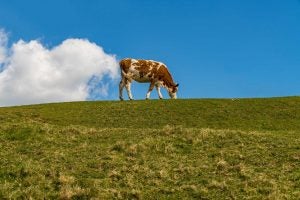As we hurtle toward crucial tipping points on a warming planet, an international team of scientists is recruiting a surprising ally to make a powerful dent in greenhouse gas emissions: the cow.
Animal sciences researchers from the University of Illinois Urbana-Champaign are driving a new project to reduce methane production from rumen fermentation in beef and dairy cattle. The three-year, $3.2-million project is part of the Greener Cattle Initiative, led by the Foundation for Food and Agriculture Research.
According to the researchers, aggressively targeting methane could help course-correct our climate trajectory on a quicker timeline than controlling carbon dioxide alone. Methane is 28 times more potent than CO2 and degrades in the atmosphere within a dozen years, compared to the hundreds of years it takes CO2 to dissipate.
“What this means is that anything we do now with ruminant animals can have a huge impact on warming within decades, rather than centuries. Our challenge is to reduce enteric methane emissions by about 30 to 40 percent with the technologies we have,” said project leader Rod Mackie, professor in the Department of Animal Sciences, part of the College of Agricultural, Consumer and Environmental Sciences at U. of I.
The project involves six research hubs around the world, all tackling the challenge of enteric methane, which is produced in the rumen as part of the microbial fermentation process. Mackie, along with Illinois animal sciences professor Josh McCann, will start by tracking hydrogen production and utilization during fermentation.
A key step in the fermentation process is the regeneration of a high-energy carrier molecule known as NADH. For microbes to keep producing energy during glycolysis, NADH has to dump its hydrogen — the H in NADH — and wait for a recycled one to take its place from breakdown of carbohydrates and other fermentable organic matter provided in the diet. Normally, the excess hydrogen from NADH is used to convert CO2 to methane, a molecule comprised of one carbon and four hydrogen atoms. However, the research team thinks there may be ways to redirect the excess hydrogens towards more productive end-products.

“In anaerobic fermentation in the rumen, you have to have some way of recycling hydrogen through the conversion of NADH to NAD. In that process, most of the excess hydrogen goes towards methane. If you shut down methane production, hydrogen builds up and inhibits glycolysis,” Mackie said. “We don’t want that to happen. Instead, we want to redirect hydrogen into other products, such as propionate and butyrate, reduced fatty acids that serve as the primary energy source for all ruminants.”
McCann added, “There are a lot of groups working on inhibiting methane directly using dietary additives. Our focus is trying to figure out how we actually make it work in an animal and make it more energetically feasible. That’s really been the missing piece,” he said. “If cows can’t metabolize the excess hydrogens for productive benefit and to improve growth, there will continue to be limited adoption of methane reduction strategies or additives. There’s no economic incentive.”
The team will start by taking a close look at hydrogen production and utilization in the lab. They will take rumen microbial communities from beef cattle that naturally produce more or less methane to explore potential adjustments they can make to the system with promising inhibitor compounds. Later, they will bring their findings back into cows.
“Most of the grant is focused on the basic and the mechanistic side, but once we make something that might work within a microbial community, it still has to work in an animal,” McCann said. “We have complicating factors like diet components and how much they want to eat. Not to mention dairy cattle and beef cattle are eating different things, so the bugs in the rumen function differently. So, if we apply a methane inhibitor to a dairy microbial community, we might have to approach the hydrogen capture a little bit differently than in a beef rumen community.”
Mackie said the project is the beginning of a longer-term endeavor to find enteric methane solutions. But by the end of three years, the goal is to be able to recommend specific amounts of inhibitors that don’t hinder or even improve production performance.
Beyond that? “What we’d like is to have ruminants save the planet within 10 years,” he said. “That would be amazing.”


